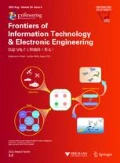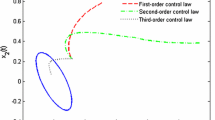Abstract
This paper presents a new approach for solving a class of infinite horizon nonlinear optimal control problems (OCPs). In this approach, a nonlinear two-point boundary value problem (TPBVP), derived from Pontryagin’s maximum principle, is transformed into a sequence of linear time-invariant TPBVPs. Solving the latter problems in a recursive manner provides the optimal control law and the optimal trajectory in the form of uniformly convergent series. Hence, to obtain the optimal solution, only the techniques for solving linear ordinary differential equations are employed. An efficient algorithm is also presented, which has low computational complexity and a fast convergence rate. Just a few iterations are required to find an accurate enough suboptimal trajectory-control pair for the nonlinear OCP. The results not only demonstrate the efficiency, simplicity, and high accuracy of the suggested approach, but also indicate its effectiveness in practical use.
Similar content being viewed by others
References
Abu-Khalaf, M., Huang, J., Lewis, F.L., 2006. Nonlinear H 2/H ∞ Constrained Feedback Control: a Practical Design Approach Using Neural Networks. Springer-Verlag, New York.
Adomian, G., Adomian, G.E., 1984. A global method for solution of complex systems. Math. Model., 5(4):251–263. [doi:10.1016/0270-0255(84)90004-6]
Arnold, V.I., 1992. Ordinary Differential Equations. Springer-Verlag, New York.
Ascher, U.M., Mattheij, R.M.M., Russel, R.D., 1995. Numerical Solution of Boundary Value Problems for Ordinary Differential Equations. SIAM, Philadelphia.
Banks, S.P., Dinesh, K., 2000. Approximate optimal control and stability of nonlinear finite- and infinite-dimensional systems. Ann. Oper. Res., 98(1/4):19–44. [doi:10.1023/A:1019279617898]
Bazaraa, M.S., Sherali, H.D., Shetty, C.M., 2006. Nonlinear Programming Theory and Algorithms (3rd Ed.). John Wiley & Sons, New York. [doi:10.1002/0471787779]
Beard, R.W., Saridis, G.N., Wen, J.T., 1997. Galerkin approximations of the generalized Hamilton-Jacobi-Bellman equation. Automatica, 33(12):2159–2177. [doi:10.1016/S0005-1098(97)00128-3]
Bellman, R., 1952. On the theory of dynamic programming. PNAS, 38(8):716–719. [doi:10.1073/pnas.38.8.716]
Bryson, A.E., 2002. Applied Linear Optimal Control: Examples and Algorithms. Cambridge University Press, UK.
Cimen, T., 2008. State-Dependent Riccati Equation (SDRE) Control: a Survey. 17th IFAC World Congress. [doi:10.3182/20080706-5-KR-1001.00635]
Garrard, W.L., Jordan, J.M., 1977. Design of nonlinear automatic flight control systems. Automatica, 13(5):497–505. [doi:10.1016/0005-1098(77)90070-X]
Huang, J., Lin, C.F., 1995. Numerical approach to computing nonlinear H-infinity control laws. J. Guid. Control Dyn., 18(5):989–994. [doi:10.2514/3.21495]
Hwang, I., Li, J., Du, D., 2009. Differential transformation and its application to nonlinear optimal control. J. Dyn. Syst. Meas. Control, 131(5):051010–11. [doi:10.1115/1.3155013]
Junkins, J.L., Turner, J.D., 1986. Optimal Spacecraft Rotational Maneuvers. Elsevier, Amsterdam.
Khatibi, M., Shanechi, H.M., 2011. Using modal series to analyze the transient response of oscillators. Int. J. Circ. Theor. Appl., 39(2):127–134. [doi:10.1002/cta.621]
Lyapunov, A.M., 1892. General Problem on Stability of Motion. Fuller, A.T., translator, 1992. Taylor & Francis, London (in Russian).
Manousiouthakis, V., Chmielewski, D.J., 2002. On constrained infinite-time nonlinear optimal control. Chem. Eng. Sci., 57(1):105–114. [doi:10.1016/S0009-2509(01)00359-1]
McCaffrey, D., Banks, S.P., 2005. Geometric existence theory for the control-affine nonlinear optimal regulator. J. Math. Anal. Appl., 305(1):380–390. [doi:10.1016/j.jmaa.2004.12.017]
Murdock, J.A., 1999. Perturbations: Theory and Methods. Classics in Applied Mathematics. SIAM, Philadelphia.
Notsu, T., Konishi, M., Imai, J., 2008. Optimal water cooling control for plate rolling. Int. J. Innov. Comput. Inform. Control, 4(12):3169–3181.
Pariz, N., 2001. Analysis of Nonlinear System Behavior: the Case of Stressed Power Systems. PhD Thesis, Department of Electrical Engineering, Ferdowsi University of Mashhad, Iran.
Pariz, N., Shanechi, H.M., Vaahedi, E., 2003. Explaining and validating stressed power systems behavior using modal series. IEEE Trans. Power Syst., 18(2):778–785. [doi:10. 1109/TPWRS.2003.811307]
Pontryagin, L.S., 1959. Optimal control processes. Usp. Mat. Nauk, 14:3–20 (in Russian).
Shanechi, H.M., Pariz, N., Vahedi, E., 2003. General nonlinear modal representation of large scale power systems. IEEE Trans. Power Syst., 18(3):1103–1109. [doi:10.1109/TPWRS.2003.814883]
Tang, G.Y., 2005. Suboptimal control for nonlinear systems: a successive approximation approach. Syst. Control Lett., 54(5):429–434. [doi:10.1016/j.sysconle.2004.09.012]
Tang, G.Y., Qu, H.P., Gao, Y.M., 2002. Sensitivity approach of suboptimal control for a class of nonlinear systems. J. Ocean Univ. Qingdao, 32(4):615–620 (in Chinese).
Tang, L., Zhao, L.D., Guo, J., 2009. Research on pricing policies for seasonal goods based on optimal control theory. ICIC Expr. Lett., 3(4B):1333–1338.
Wu, F.X., Wu, H., Han, Z.X., Gan, D.Q., 2007. Validation of power system non-linear modal analysis methods. Electr. Power Syst. Res., 77(10):1418–1424. [doi:10.1016/j.epsr.2006.10.016]
Yousefi, S.A., Dehghan, M., Lotfi, A., 2010. Finding the optimal control of linear systems via He’s variational iteration method. Int. J. Comput. Math., 87(5):1042–1050. [doi:10.1080/00207160903019480]
Author information
Authors and Affiliations
Corresponding author
Rights and permissions
About this article
Cite this article
Jajarmi, A., Pariz, N., Effati, S. et al. Solving infinite horizon nonlinear optimal control problems using an extended modal series method. J. Zhejiang Univ. - Sci. C 12, 667–677 (2011). https://doi.org/10.1631/jzus.C1000325
Received:
Accepted:
Published:
Issue Date:
DOI: https://doi.org/10.1631/jzus.C1000325
Key words
- Infinite horizon nonlinear optimal control problem
- Pontryagin’s maximum principle
- Two-point boundary value problem
- Extended modal series method




